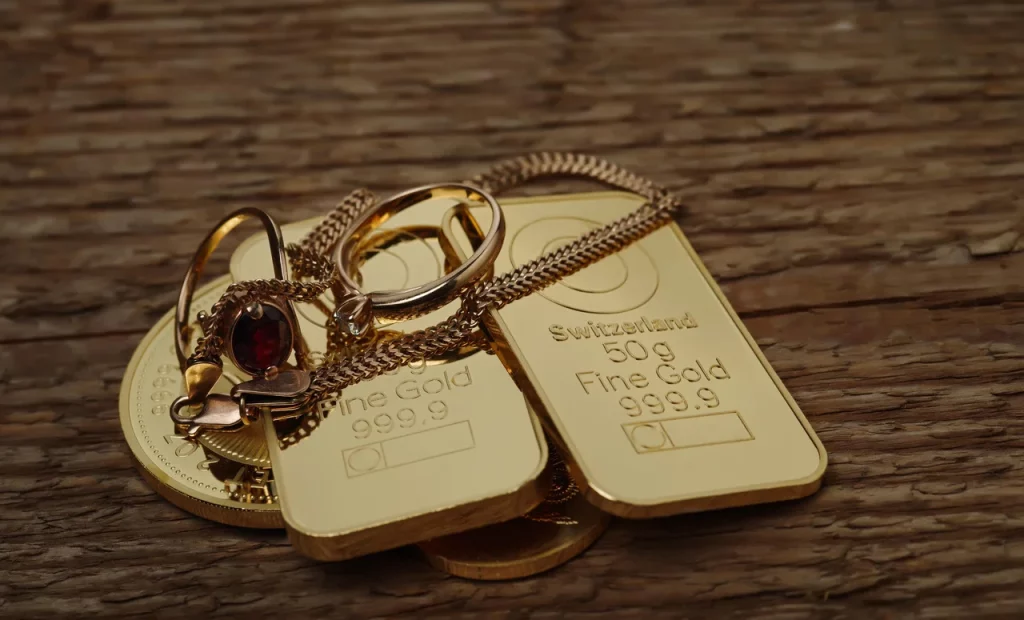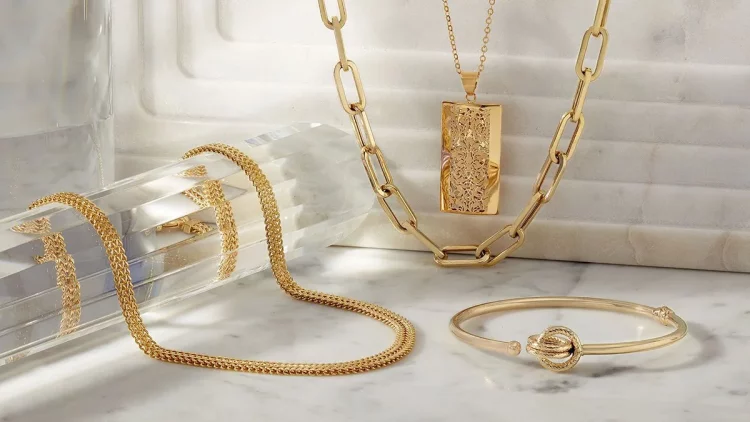Gold jewelry has long been admired not only for its beauty but also for its potential as an investment. Unlike other forms of gold investments, such as bullion or coins, gold jewelry offers a unique combination of aesthetics and value. However, investing in gold jewelry is not as straightforward as purchasing gold bars or coins. It involves careful consideration of factors such as craftsmanship, brand reputation, and market trends. This article will explore the key factors to consider when investing in gold jewelry, helping you navigate the complex jewelry market to make informed decisions for long-term growth.
Key Factors to Consider When Investing in Gold Jewelry
When you decide to invest in gold jewelry, it is essential to look beyond just the price of the gold itself. Several factors affect the value of gold jewelry, and understanding these elements can significantly impact your investment’s future return.
1. Gold Purity and Weight
The first and most obvious factor to consider when investing in gold jewelry is its purity. Gold is typically measured in karats, with 24 karat (24K) being pure gold. However, gold jewelry is often alloyed with other metals such as copper or silver to improve its durability. The higher the karat, the purer the gold, and the more valuable the jewelry will be in terms of its gold content. However, 24K gold jewelry may not be as durable for daily wear as 18K or 22K gold, which might influence its practicality and desirability as an investment.
Weight is also a crucial consideration. The heavier the piece, the more gold it contains, and consequently, the higher the intrinsic value of the jewelry. When buying gold jewelry for investment purposes, it is important to factor in both the purity and weight to assess its overall value.
2. Craftsmanship and Design
While the intrinsic value of gold jewelry is driven by its gold content, the craftsmanship and design can significantly affect its price. High-quality craftsmanship, intricate designs, and the reputation of the designer or manufacturer can increase the perceived value of a piece of jewelry, making it more valuable to collectors. Pieces with unique or historically significant designs tend to appreciate more over time, as they often become more desirable and harder to find.
Brand and designer reputation also play a significant role in the pricing of gold jewelry. Renowned jewelers and designers can command a premium for their creations due to their established reputation and track record for quality. For example, jewelry by iconic brands like Cartier, Tiffany & Co., or Van Cleef & Arpels can fetch significantly higher prices than lesser-known brands or mass-produced pieces.
3. Scarcity and Rarity
Another factor that can contribute to the value of gold jewelry is its scarcity. Limited edition pieces, special collections, or jewelry featuring rare gemstones can be more valuable due to their rarity. The scarcity of a piece can be determined by factors such as the number of items produced, the availability of specific designs, and the demand for particular styles or themes.
Vintage gold jewelry, especially pieces from well-known time periods or collections, can also hold significant value. Vintage jewelry often carries a premium due to its historical significance and the rarity of certain designs. In some cases, antique gold jewelry may increase in value over time, making it an attractive option for long-term investment.
Understanding the Value of Brand, Design, and Scarcity in Pricing
When purchasing gold jewelry as an investment, it is essential to understand the dynamics of brand value, design, and rarity, as these factors greatly influence pricing.
Brand Value
The brand or designer behind the jewelry is one of the most significant price influencers. High-end brands like Chanel, Cartier, and Bulgari have a strong market presence and loyal customer base, meaning their pieces are often worth more than non-branded or lesser-known items. Jewelry by top-tier designers typically holds its value well and may even appreciate over time due to the brand’s reputation and desirability.
For example, Cartier’s Love Bracelet is an iconic piece of jewelry that retains its value in the market. The brand’s name, alongside the high-quality craftsmanship, contributes to a strong resale value, making it a reliable investment for those looking to buy gold jewelry.
Design and Craftsmanship
Unique, well-executed designs can dramatically affect a piece’s market value. Jewelry with intricate or unique designs, especially those made by renowned artists or designers, will often command a higher price. High craftsmanship quality is equally important. Well-made jewelry is not only more durable but also more likely to appreciate in value as it becomes a highly sought-after collector’s item. Items such as vintage or antique gold jewelry that showcase excellent artistry and craftsmanship can experience notable value growth over time.

Scarcity and Rarity
Scarcity is a fundamental concept in the value of any luxury item, and gold jewelry is no exception. Limited edition collections, pieces featuring rare or valuable gemstones, and designs that are no longer in production are more likely to increase in value over time due to their rarity. The scarcer the piece, the more likely it is to appreciate in value as collectors and investors compete to own a rare item.
Vintage and antique gold jewelry is often considered valuable because of its historical importance and rarity. Items that have been discontinued, or have limited production runs, may see price increases over time due to their growing scarcity.
When and Where to Buy Gold Jewelry for Investment Purposes
Knowing when and where to buy gold jewelry is just as important as understanding the jewelry’s intrinsic and aesthetic value. Timing your purchase based on the market conditions and buying from reputable sources can help maximize the potential return on investment.
When to Buy
Like any investment, timing plays a key role in maximizing returns when purchasing gold jewelry. The best time to buy gold jewelry as an investment is typically when the price of gold is low or stable. Just as gold bullion prices fluctuate, the prices of gold jewelry are influenced by market trends, inflation, and economic conditions. Purchasing gold jewelry during periods of low gold prices allows investors to acquire more valuable pieces for a lower cost.
Similarly, understanding the seasonal fluctuations in jewelry demand is essential. Gold prices tend to increase during peak holiday seasons, such as Christmas or Valentine’s Day, when consumer demand is at its highest. Buying gold jewelry during off-peak times or when market conditions are more favorable can help you avoid inflated prices due to high demand.
Where to Buy
It’s important to buy gold jewelry from reputable sources to ensure its authenticity and value. Consider purchasing from well-established jewelry brands, high-end boutiques, or trusted online platforms. Buying from reputable jewelers ensures that you are getting authentic, high-quality gold jewelry that will hold its value over time. Additionally, buying from reputable dealers means you can be confident in the purity and weight of the gold, which is crucial for investment purposes.
Auction houses and estate sales are other potential places to find valuable gold jewelry. These venues often feature rare or vintage pieces that may not be available through conventional retail outlets. However, it’s crucial to do your research before buying from these sources, as the market for antique or rare pieces can be highly speculative.
Tips for Evaluating Gold Jewelry’s Long-Term Growth Potential
Evaluating the potential for long-term growth in gold jewelry involves more than just assessing its immediate market value. Here are some key tips for evaluating its future investment potential:
1. Research Market Trends
Before purchasing gold jewelry, research the current trends in the jewelry market. Pay attention to demand for specific designs, brands, and gold purity levels. Emerging trends in sustainability, ethical sourcing, and minimalist designs may also influence future value.
2. Consider the Jewelry’s Rarity and Demand
As with any collectible, scarcity is key to driving future value. Look for pieces that are limited edition, vintage, or from well-known designers. These pieces are more likely to increase in value over time due to demand from collectors and investors.
3. Focus on Quality Craftsmanship
Investing in well-crafted jewelry ensures that the piece will stand the test of time. High-quality craftsmanship not only enhances the aesthetic appeal of the piece but also makes it more likely to appreciate in value over the long term.
4. Think Long-Term
Gold jewelry, like other forms of investment, requires patience. While it may not offer immediate returns, it can serve as a store of value and a long-term investment. Focus on acquiring pieces that will hold their value over time and potentially appreciate due to scarcity, craftsmanship, or brand reputation.
Conclusion
Investing in gold jewelry can be a rewarding and enjoyable way to grow your wealth. However, it requires careful consideration of factors such as purity, craftsmanship, brand value, and scarcity. By understanding these elements and staying informed about market trends, you can make educated decisions when buying gold jewelry for investment purposes. Whether you are looking to acquire high-end designer pieces, vintage jewelry, or limited-edition collections, gold jewelry can offer a unique combination of beauty and financial potential for those who choose to invest wisely.



































